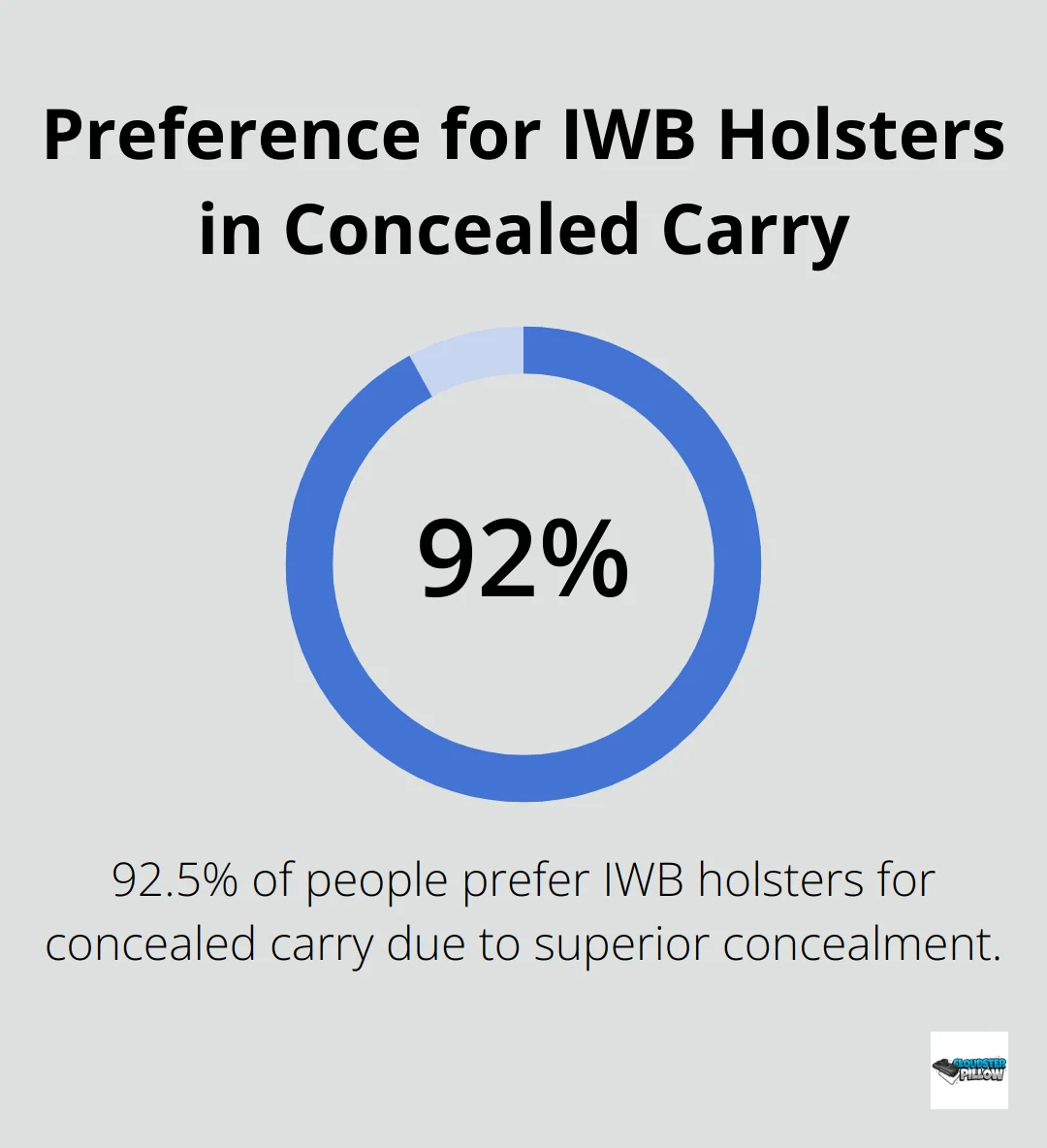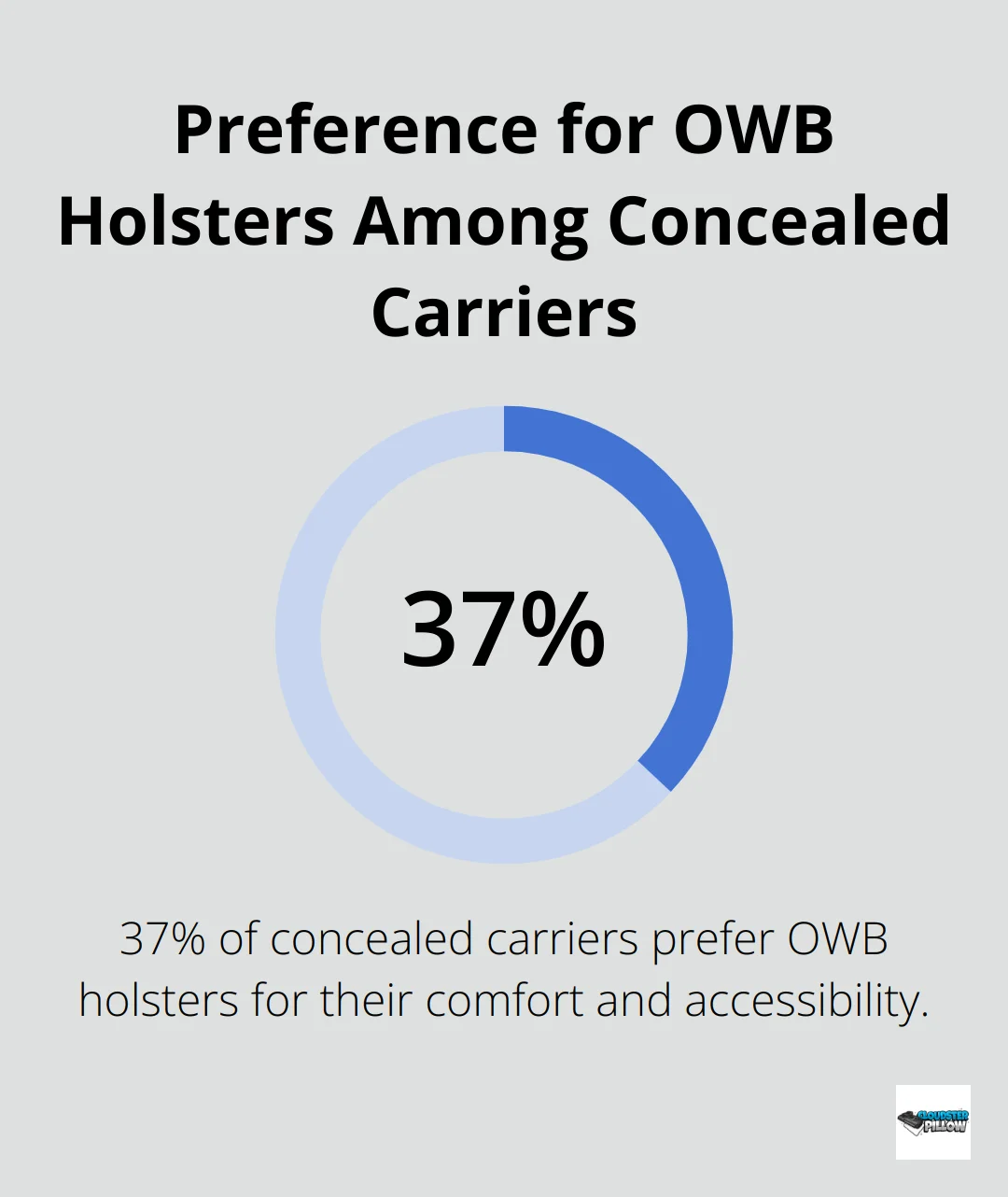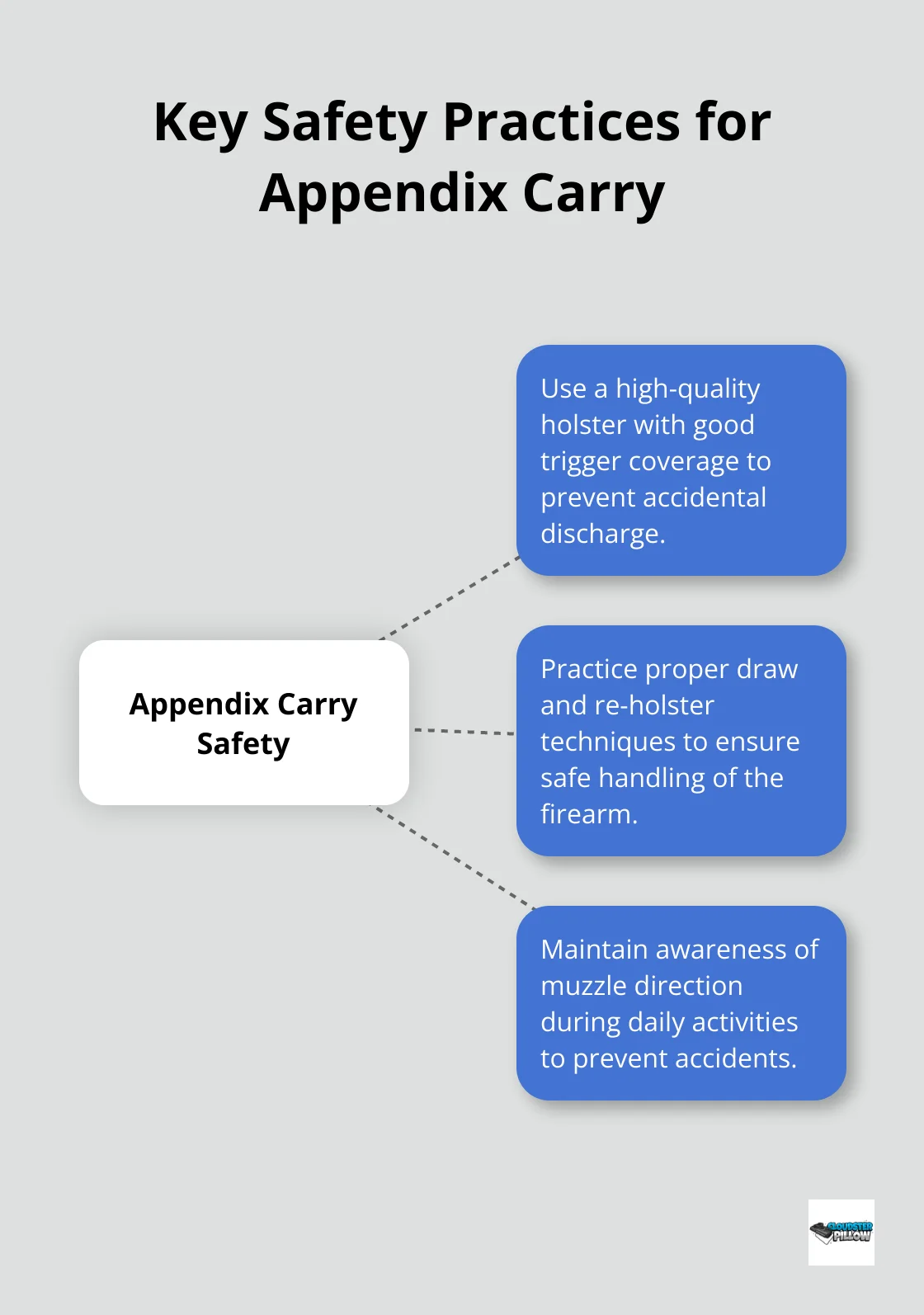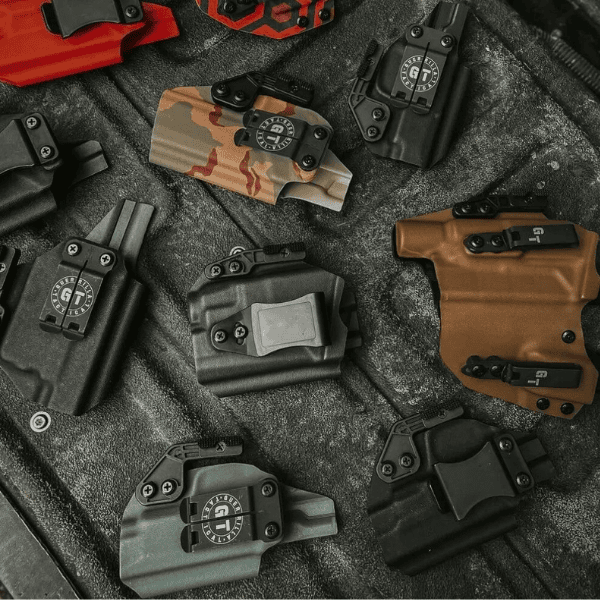EDC Gear, Holsters and Gear Recommendations
Exploring Different Types of Pistol Holsters
At Cloudster Pillow, we understand the importance of choosing the right pistol holster for your concealed carry needs.
Pistol holster types come in various designs, each offering unique benefits for different carrying styles and situations.
In this guide, we’ll explore the most common holster options to help you make an informed decision for your everyday carry setup.
What Are IWB Holsters?
Definition and Placement
Inside the Waistband (IWB) holsters stand out as a top choice for concealed carry. These pistol holsters fit inside your pants, securing your firearm close to your body. This placement offers a perfect balance of concealment and accessibility.
Concealment Advantages
IWB holsters excel at hiding your firearm. The gun’s position inside your waistband leaves only the grip visible above your belt line. This design minimizes printing (the visible outline of your gun through clothing). A study found that 90-95% of people prefer IWB holsters for concealed carry due to their superior concealment.

Comfort Considerations
While IWB holsters offer great concealment, comfort can present a challenge. The gun’s pressure against your body may cause discomfort during extended wear. Many IWB pistol holsters now feature padding or sweat guards to address this issue. The Cloudster Pillow accessory dramatically improves comfort for any IWB setup.
Popular IWB Holster Options
Several reputable brands offer high-quality IWB pistol holsters:
- Vedder Holsters’ LightTuck (known for adjustable cant and ride height)
- Alien Gear Cloak Tuck 3.5 (provides comfortable neoprene backing)
- Tier 1 Concealed Axis Slim (top choice for appendix carry)
When you select an IWB holster, consider factors like retention, draw speed, and compatibility with your specific firearm model. Always practice drawing from your chosen holster to build muscle memory and ensure safe handling.
Transition to OWB Holsters
While IWB pistol holsters offer excellent concealment, some situations call for a different approach. Outside the Waistband (OWB) holsters provide an alternative that prioritizes quick access and comfort. Let’s explore how OWB holsters compare to their IWB counterparts and when they might be the better choice for your carry needs.
Why Choose OWB Holsters?
Open Carry and Range Applications
Outside the Waistband (OWB) holsters offer a different approach to carrying your firearm. These holsters excel in situations where quick access and comfort take precedence over discreet carry. For states that allow open carry, OWB holsters provide a visible deterrent and faster draw times. A National Shooting Sports Foundation survey reveals that 37% of concealed carriers prefer OWB holsters for their comfort and accessibility.

Superior Draw Speed and Access
The primary advantage of OWB holsters is their quick draw capability. A Force Science Institute study found that shooters using OWB holsters could draw and fire accurately 0.5 seconds faster on average compared to IWB holsters. This time difference (which may seem small) can prove vital in high-stress situations where every fraction of a second counts.
Materials and Design Options
OWB holsters come in various materials, each with unique benefits:
- Leather: Offers a classic look and molds to your body over time
- Kydex: Provides a lightweight, durable option that maintains its shape
- Hybrid: Combines a leather backing with a Kydex shell for comfort and retention
Popular OWB designs include paddle holsters (which easily clip on and off your belt) and belt slide holsters (that thread through your belt for added security). The Safariland 7TS duty holsters feature precision injection-molding, making them extremely lightweight and durable.
Selecting the Right OWB Holster
When you choose an OWB holster, consider factors like retention level, adjustability, and compatibility with your specific firearm model. Try to find a balance between security and ease of access that suits your needs and preferences.
While OWB holsters offer clear advantages in certain situations, they may not suit all concealed carry needs. For those times when you need to switch to more discreet carry, you might want to explore IWB options. This brings us to our next topic: appendix carry holsters, which offer a unique blend of concealment and accessibility.
Why Appendix Carry Pistol Holsters Are Gaining Popularity
Rapid Access and Concealment Benefits
Appendix carry holsters have become increasingly popular among concealed carriers due to their unique blend of accessibility and concealment. This carry method positions the firearm at the front of the body, typically between 12 and 2 o’clock on the waistline.
The primary advantage of appendix carry is the speed of draw. As with all the belly bands here, you can affix the PT-ONE to carry a weapon strong-side, weak-side, or anywhere in between. Its size and design make it best for various carry positions, including appendix carry.
Concealment is another strong point for appendix carry. The firearm sits in a natural hollow of the body, which reduces the likelihood of printing through clothing. Many users find they can conceal larger firearms more effectively with this method.
Addressing Comfort Concerns
While appendix carry offers significant benefits, comfort can challenge some users. The gun’s position at the front of the body may cause discomfort, especially when sitting or bending. Accessories like wedges (such as the Cloudster Pillow) add a layer of cushioning between the firearm and the body, which significantly enhances comfort for all-day carry.
Safety Considerations
Safety remains paramount for appendix carry. The muzzle of the firearm points at sensitive areas of the body, which understandably raises concerns for some carriers. However, proper training and adherence to safety protocols make appendix carry just as safe as other methods.
Key safety practices for appendix carry include:
- Use of a high-quality holster with good trigger coverage
- Practice of proper draw and re-holster techniques
- Maintenance of awareness of muzzle direction during daily activities

Renowned firearms instructor Todd Green emphasizes the importance of slow, deliberate re-holstering, stating, “Look the gun into the holster. If you’re distracted, stop and reassess.”
Choosing the Right Holster
When selecting an appendix carry holster, consider factors like retention, concealment features, and compatibility with your specific firearm model. Top choices in the market include the Tier 1 Concealed Axis Elite and the PHLster Pro Series (with the Cloudster Pillow as the top choice for a comfort-enhancing accessory). These holsters offer adjustable retention, modular designs, and built-in features for enhanced comfort and concealment.
Appendix carry holsters continue to evolve, with manufacturers focusing on improving comfort and concealment. As more carriers discover the benefits of this method, we can expect to see further innovations in holster design and carry accessories.
FAQs
1. What are the benefits of using an IWB holster for concealed carry?
Inside the Waistband (IWB) holsters are a top choice for concealed carry because they provide superior concealment. The firearm is carried inside your waistband, leaving only the grip visible above your belt line. This minimizes printing and keeps the firearm discreet. IWB holsters also offer good accessibility, making them suitable for everyday carry.
2. How does an OWB holster differ from an IWB holster?
Outside the Waistband (OWB) holsters prioritize quick access and comfort, making them ideal for open carry and range applications. OWB holsters provide faster draw times—on average, 0.5 seconds faster than IWB holsters—because they sit outside the waistband, making the firearm easier to reach. However, they are generally less concealable than IWB holsters, making them better suited for situations where discretion is not as crucial.
3. Why is appendix carry becoming more popular for concealed carry?
Appendix carry has gained popularity because it offers a unique combination of rapid access and concealment. Carrying the firearm at the front of the body allows for a faster draw, and many users find they can conceal larger firearms more effectively in this position. Accessories like the Cloudster Pillow improve comfort during appendix carry, addressing concerns about discomfort, especially while sitting or bending.
4. What should I look for when choosing an appendix carry holster?
When selecting an appendix carry holster, consider factors such as retention, comfort, concealment, and compatibility with your firearm. A good holster should offer secure retention to prevent accidental discharges, have a comfortable design (especially for all-day wear), and fit your body type and clothing choices. Popular choices include the Tier 1 Concealed Axis Elite and PHLster Pro Series, both known for their adjustable retention and modular designs.
5. How can the Cloudster Pillow enhance my holster experience?
The Cloudster Pillow is a holster accessory designed to enhance comfort for both IWB and appendix carry holsters. It provides cushioning between the firearm and your body, significantly reducing pressure points and increasing overall comfort during extended wear. By improving comfort, the Cloudster Pillow also helps reduce the likelihood of discomfort that may cause you to leave your firearm behind, ensuring you’re always prepared to carry.
Final Thoughts
Your choice of pistol holster types impacts your safety, comfort, and carrying experience. Inside the Waistband (IWB) holsters prioritize concealment, Outside the Waistband (OWB) holsters offer quick access, and appendix carry holsters balance both. Your selection should match your needs, body type, and preferences, considering factors like retention, draw speed, and concealment.
Practice with your chosen holster builds muscle memory and enhances your draw technique. Regular training, including dry fire exercises and live fire sessions, increases your overall confidence. This dedication to practice ensures you can effectively use your holster in various situations.
The Cloudster Pillow enhances carrying comfort for IWB and appendix carry holsters. This accessory reduces pressure points and improves concealment (making all-day carry more comfortable). Experiment with different holster types to find your perfect carry setup, as the world of concealed carry continues to evolve with new innovations.


Pingback: Choosing the Best IWB Holster for Your Needs - Cloudster Pillow
Pingback: How to Wear an Appendix Holster: A Complete Guide - Cloudster Pillow